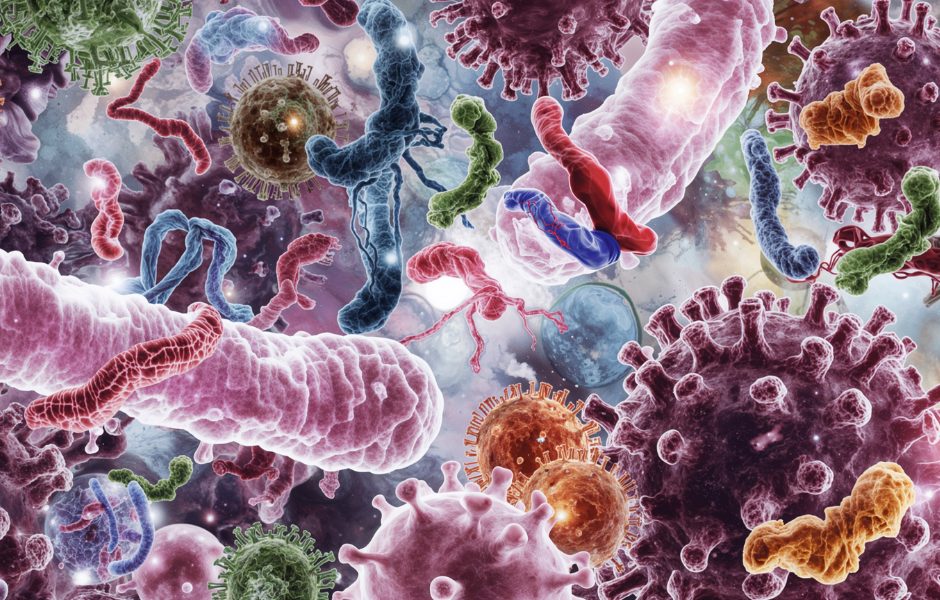
This children’s science article, What is the microbiome? A kids’ guide to the tiny world inside you, has been written for native English speakers and learners of English as a second or foreign language. It can help children practise reading and comprehension, learn useful biology vocabulary, and discover how microscopic life helps to keep humans healthy. Written by Sinead O’Carroll, an experienced English teacher and writer.
What is the microbiome?
Every person on Earth carries an invisible world inside them called the microbiome. It is made up of trillions of tiny living things, including bacteria, fungi, and viruses. Most of these are microbes, so small that you can only see them under a microscope.
You may think they sound harmful, but many of these microbes are actually helpful and work together to keep your body balanced and healthy.
Where does the microbiome live?
Microbes live everywhere on your body – on your skin, in your mouth, and especially in your gut. The gut is the long tube that runs from your mouth to your intestines. Inside it lives a huge community of friendly bacteria that help to digest your food, make vitamins, and even send signals to your brain.
Scientists have discovered that your microbiome is unique, like a fingerprint. The mix of microbes inside you depends on what you eat, where you live, and how you spend your time.
Why our microbiome is important
A healthy microbiome helps protect you from germs that can make you ill. It also supports your immune system, which defends your body from disease. Some research even suggests that your microbiome can affect your mood and the way you think, showing how connected the body and mind can be.
When your microbiome becomes unbalanced, for example, after taking medicine such as antibiotics or eating too much processed food, your digestion or energy levels might change. Scientists are studying how to keep the microbiome strong through diet, exercise, and how we spend our time.
How can you look after your microbiome?
One of the best ways to care for your microbiome is through diverse eating. Fruits, vegetables, grains, and yoghurt can feed different kinds of helpful microbes. Getting enough sleep, spending time outdoors, and playing with pets can also help keep your microbiome varied and healthy.
It is not about avoiding all bacteria, it is about keeping the right balance. Your microbiome is like a garden. If you feed it well, the good microbes will grow and protect you.
To explore more about microbes and the human body, you can visit Gut Microbiome – Cleveland Clinic.

Article vocabulary list
- Microbiome – all the tiny living organisms that live in and on your body.
- Microbe – a very small living thing that can only be seen with a microscope.
- Gut – the part of your body where food is digested, including your stomach and intestines.
- Digest – to break down food in the body so it can be used for energy.
- Immune system – the body’s defence system that fights germs and disease.
- Bacteria – tiny living cells, some of which can help or harm living things.
- Antibiotic – a medicine that kills bacteria or stops them from growing.
- Diverse – having many different types or kinds.
- Balanced – having the right mix or amount of things so everything works well.
- Microscope – a tool used to see things that are too small for the eye to see.
Comprehension questions
Just click the plus (+) to see the answer
1. What is the microbiome made up of?
a) Only viruses
b) Tiny living things like bacteria and fungi
c) Parts of the brain
Answer: b) Tiny living things like bacteria and fungi
2. Where does most of your microbiome live?
a) In your gut
b) On your hair
c) In your bones
Answer: a) In your gut
3. What does the microbiome help you do?
a) Digest food and stay healthy
b) Sleep longer
c) Grow taller
Answer: a) Digest food and stay healthy
4. What can make the microbiome unbalanced?
a) Exercise
b) Antibiotics
c) Playing outside
Answer: b) Antibiotics
5. How can you look after your microbiome?
a) By eating a variety of foods and getting enough sleep
b) By avoiding all bacteria
c) By taking more medicine
Answer: a) By eating a variety of foods and getting enough sleep
6. What can you use to see microbes?
a) A microscope
b) Sunglasses
c) A telescope
Answer: a) A microscope
Sinead is a writer and EFL teacher with eight years’ experience. She’s a native English speaker who loves making news stories fun and easy to understand for children around the world. Her passions include travel, animals, and helping to make the world a kinder, more sustainable place.




